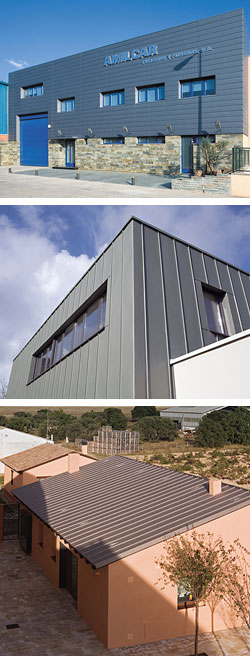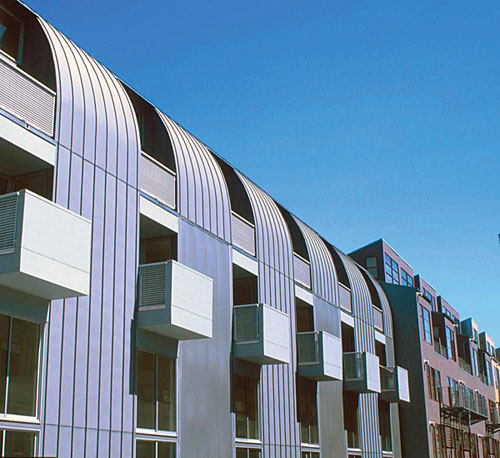Zinc: The Sustainable Choice among Architectural Metals
• Common construction uses: Zinc is commonly used as a stand-alone metal product or in combination with other metals for a variety of uses that you are probably already familiar with:
Zinc is mixed with copper to form brass
Zinc is the primary metal used to galvanize steel, causing a chemical reaction that protects the steel from rust and corrosion
Rolled and sheet zinc is fabricated into interior and exterior wall panel products for both decorative and functional purposes
Rolled zinc is fabricated into standing seam and other types of metal roofing products
Metal flashings and roof accessories are fabricated from zinc as an alternative to copper and other metals
Historical building ornaments such as metal finials, vanes, campaniles, dormers, etc. can all be fabricated out of zinc
Rainwater collection gutters and downspouts made from zinc are an alternative to other metals
Zinc is used in batteries and recently in fuel cells for alternative energy solutions
 |
Zinc forms a natural protective patina that can be influenced by manufacturers to create different hues of color. Photo: VM Zinc USA |
• Standards: Products manufactured out of zinc are subject to strict standards that determine the quality and purity of the material since most of what we refer to as zinc metal is in fact an alloy containing well over 99 percent zinc mixed with trace amounts of copper, titanium, and aluminum. ASTM B6 - 09 "Standard Specification for Zinc" covers zinc metal made from ore or other material by a process of distillation or by electrolysis in five grades: LME grade (related to the London Metal Exchange standards), special high grade, high grade, intermediate grade, and prime western grade. Under this standard, the zinc metal is tested to conform to chemical composition requirements free of any surface corrosion and adhering foreign matter. The most common building related standard for products then manufactured out of zinc metal is ASTM B69-09 "Standard Specification for Rolled Zinc." This standard covers Type I coils or sheets cut from strip rolled zinc, and Type II zinc plates such as boiler and hull plates produced by any rolling method. This standard tests for chemical composition, tensile properties, and hardness. In Europe, zinc must meet similar stringent testing requirement under EN988 which also dictates the specific zinc material characteristics to be used in building products.
These characteristics and others of zinc have contributed to its widespread use around the world for centuries. In fact, the use of zinc as a building material can be traced back to the 1st Century ruins of Pompeii and even earlier. Zinc roofing in Europe has been used extensively since the 13th century as evidenced by the fact that approximately 85 percent of the current rooftops in Paris are made from zinc. With this long history of use, the knowledge base about zinc as a sustainable and durable building product are well documented and readily known.
In addition to the strong historical track record of zinc, architects should also be aware that there are some emerging trends and practices of companies that manufacture zinc building products that will make it easier to specify and design zinc into buildings in the US. First is the offering of material in 48-inch-wide products instead of only the previously available meter wide material. This coordination with American standard construction sizes will make it easier to design and install zinc wall and roofing products at new scales and with more economical installation. Second is the expanding range of color choices offered by some manufacturers. While maintaining the positive durability effects of the zinc patina, some products can be color managed through a pre-patina process meaning that the material will arrive onsite already showing some of its patination and coloring ahead of typical time frames. Third, is a global approach to the fabrication and service for a specific product. This means that a product can be specified in the US for a project in Europe, China, or the Middle East and have exactly the same make up and characteristics in any of those locations. Finally, zinc is being used innovatively to improve building performance such as rainscreen products that harness air flow in parts of the building envelope for enhanced heating, cooling, and ventilation. Coupling all of this with a growing awareness of an envelope that meets a strong and positive life cycle cost analysis, architects and designers are becoming increasingly savvy in making long term choices that allow for both contemporary and traditional aesthetics, even allowing a seamless flow from roofing to walls in some cases.
 |
Third Street Lofts, in San Francisco, CA uses zinc for continuous roof and wall panels. Photo: VM Zinc USA |









